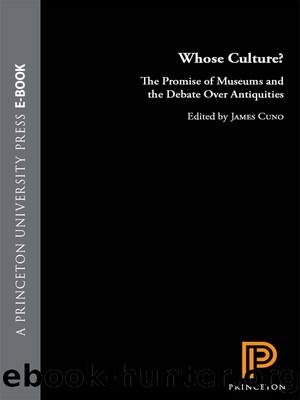Whose Culture? by Cuno James;

Author:Cuno, James;
Language: eng
Format: epub
Publisher: Princeton University Press
Published: 2012-06-14T16:00:00+00:00
CONTEXTS AND CONTEXTS
It comes down to a very fundamental division in museums. There are art museums and there are what can generally be called natural history or history museums. For the latter the context is very important for the objects. It’s all about the history and reconstructing the history via the artifacts. The art museums have the concept that it is the object, the aesthetic, that’s primary.9
The observation is, of course wrong, at any level of interpretation, but it demonstrates the argument, often proposed by some archaeologists, that an object is historically worthless if its context of discovery is unknown; some would say unless they had actually seen it excavated. One’s understanding of the pursuit of the past through archaeology has to be extremely limited to hold such views, indeed blinkered. But the slogan that “context is everything” has an allure for some, especially those out of sympathy with any form of “collecting,” despite the fact that collecting is an activity far older than “archaeology.” It is, historically speaking, the cornerstone still of most of our understanding of antiquity as it has developed over the last 250 years. And museum collections not primarily based on excavated material remain the major resource for teaching, understanding, and much research.
The quoted statement seems also to imply that the “aesthetic” is to some degree unscientific. My own view, that art history is a branch of archaeology that many archaeologists have not the stomach to tackle, may not be widely shared, but it enables others and me not to ignore any rigorously academic “aesthetic” approach to antiquity and its historical value. I have had enough experience excavating, publishing excavation reports, and, especially, trying to understand the excavations of others from published reports, to know that an excavated context, as reported, can be very equivocal. For the majority of excavated pieces precise information is never available. The scandal of unpublished and inadequately published material from excavations is one that archaeologists, quick to decry collecting, are willing to acknowledge but do nothing about, while the fact that it is some way regarded as “my material” will often encourage an excavator from withholding information—an attitude shared by no museum that I know outside source countries, and very few private collectors.
Moreover, “excavated context” is seldom easy to define, even when it is a simple burial.
Objects whose source in the ground (which is not, after all, their true place of origin in antiquity) may not be known are given a real context by scholarship. Moreover, most objects whose source in the ground is known also depend on the intellectual context supplied for them by scholarship, of whatever source, often not archaeological at all or in any way dependent on excavation. Think of cuneiform tablets, any inscribed objects, any objects for which expertise of an art-historical nature is required to elucidate their meaning and origin. Authenticity may often be an issue but can usually be resolved by science or by application of the sort of expertise involved in reading cuneiform or deciphering iconography or individual style.
Download
This site does not store any files on its server. We only index and link to content provided by other sites. Please contact the content providers to delete copyright contents if any and email us, we'll remove relevant links or contents immediately.
Cecilia; Or, Memoirs of an Heiress — Volume 1 by Fanny Burney(32503)
Cecilia; Or, Memoirs of an Heiress — Volume 2 by Fanny Burney(31913)
Cecilia; Or, Memoirs of an Heiress — Volume 3 by Fanny Burney(31900)
The Great Music City by Andrea Baker(31759)
We're Going to Need More Wine by Gabrielle Union(19004)
All the Missing Girls by Megan Miranda(15788)
Pimp by Iceberg Slim(14440)
Bombshells: Glamour Girls of a Lifetime by Sullivan Steve(14024)
For the Love of Europe by Rick Steves(13641)
Talking to Strangers by Malcolm Gladwell(13300)
Norse Mythology by Gaiman Neil(13284)
Fifty Shades Freed by E L James(13189)
Mindhunter: Inside the FBI's Elite Serial Crime Unit by John E. Douglas & Mark Olshaker(9266)
Crazy Rich Asians by Kevin Kwan(9225)
The Lost Art of Listening by Michael P. Nichols(7456)
Enlightenment Now: The Case for Reason, Science, Humanism, and Progress by Steven Pinker(7275)
The Four Agreements by Don Miguel Ruiz(6704)
Bad Blood by John Carreyrou(6586)
Weapons of Math Destruction by Cathy O'Neil(6221)
